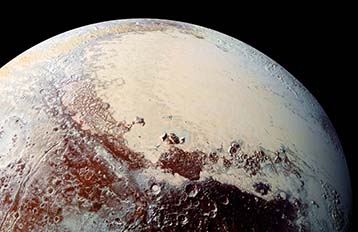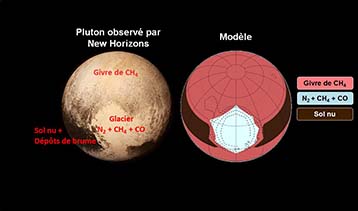
Shedding light on Pluto's glaciers
What is the origin of the large heart-shaped nitrogen glacier revealed in 2015 on Pluto by the New Horizons spacecraft? Two researchers from the Laboratoire de météorologie dynamique (CNRS/École polytechnique/UPMC/ENS Paris)1 show that Pluto's peculiar insolation and atmosphere favor nitrogen condensation near the equator, in the lower altitude regions, leading to an accumulation of ice at the bottom of Sputnik Planum, a vast topographic basin. Through their simulations, they also explain the surface distribution and atmospheric abundance of other types of volatiles observed on Pluto. These results are published in Nature on September 19, 2016.
- 1This work is supported by CNES.
Pluto is a paradise for glaciologists. Among the types of ice covering its surface, nitrogen is the most volatile: when it sublimes2
(at -235 ° C), it forms a thin atmosphere in equilibrium with the ice reservoir at the surface. One of the most unexpected observations from New Horizons, which flew by Pluto in July 2015, showed that this reservoir of solid nitrogen is extremely massive, and mostly contained in "Sputnik Planum", a topographic basin located within the tropics of Pluto. Methane frost also appears all over the northern hemisphere3
, except at the equator, while carbon monoxide ice in smaller amounts was only detected in Sputnik Planum.
Until now, the distribution of Pluto's ice remained unexplained. To better understand the physical processes at work on Pluto, the researchers developed a numerical thermal model of the surface of the dwarf planet able to simulate the nitrogen, methane and carbon monoxide cycles over thousands of years, and compared the results with the observations made by the New Horizons spacecraft. Their model shows that the solid-gas equilibrium of nitrogen is responsible for trapping the ice in Sputnik Planum. At the bottom of the basin, the pressure of the atmosphere - and therefore of gaseous nitrogen - increases, and the corresponding frost temperature is higher than outside the basin, which allows the nitrogen to preferably condense into ice4
. Simulations show that the nitrogen ice inevitably accumulates in the basin, thus forming a permanent nitrogen reservoir, as observed by New Horizons.
The numerical simulations also describe the methane and carbon monoxide cycles. Because of its volatility similar to that of nitrogen, carbon monoxide ice is entirely sequestered with nitrogen in the basin, in keeping with the New Horizonsmeasurements. Regarding the methane ice, its lower volatility at the temperatures prevailing on Pluto allows it to exist elsewhere than in the Sputnik Planum glacier. The model shows that pure methane ice seasonally covers both hemispheres, in agreement with New Horizons data.
This scenario shows that there is no need for an internal reservoir of nitrogen ice to explain the formation of the Sputnik Planum glacier, as suggested by previous studies. Instead, well-known physical principles underlie this icy cocktail on Pluto and its spectacular activity, one of the most fascinating in the Solar System. The researchers also predict that atmospheric pressure is at its seasonal peak5
and will decrease in the next decades, while seasonal frosts will tend to disappear6
.

The polar cap of « Sputnik Planum », in false colors, is surrounded by mountains which have been eroded and shaped by the glacial activity. The dark areas are covered by organic materials produced by the photolysis of methane by solar ultraviolet light.

Pluto as observed by New Horizons in July 2015 (left), compared to the model result to date (right).

Pluto similar to Mars: even though the mechanism of atmospheric condensation in the low altitude regions has no equivalent on Earth, it is already known on Mars (left), where the CO2 atmosphere can condense at the surface, like nitrogen on Pluto (right, false color, with the prominent nitrogen glacier at the bottom of Sputnik Planum at the center of the image). During the Martian winter and spring, dry ice preferentially covers the bottom of Hellas crater (at the bottom of the picture of Mars), which, like Sputnik Planum, lies several thousand meters below the level of the neighboring areas that remain free of ice.
- 2The sublimation is the process of changing from a solid to a gas.
- 3The southern hemisphere could not be observed because it was in the dark.
- 4This simple mechanism also occurs on Mars (see last figure).
- 5A Pluto year lasts 248 terrestrial years.
- 6The glacier is barely affected by the seasonal cycle.
Observed glacier and volatile distribution on Pluto from atmosphere–topography processes. Tanguy Bertrand and François Forget. Nature, September 19, 2016. DOI: 10.1038/nature19337. View web site


